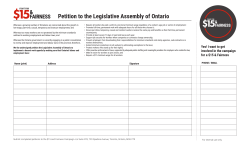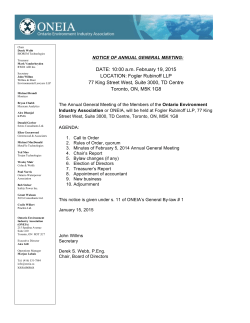
Energy & Environmental Law
Energy & Environmental Law
April 30, 2015
ONTARIO AND B.C. COURTS ALLOW CLAIMS AGAINST THE
GOVERNMENT FOR CHANGED OR STALLED DEVELOPMENT
PROJECTS TO PROCEED
By Stanley D. Berger B.C.L.,L.L.B, Certified Specialist Environmental Law
While it may not qualify as a trend, over the past month courts in both Ontario and British Columbia
have refused to strike claims against the government for frustrating development projects through
delays or changes in policy. It is too early to tell whether the plaintiffs will successfully meet their high
evidentiary burden of establishing misfeasance in the Ontario case of Capital Solar Power Corp. v
Ontario Power Authority (2015) ONSC 2116 and negligence and misfeasance in the B.C.case of
Carhoun & Sons Enterprises Ltd. v Canada (Attorney General) 2015 BCCA 163. That will be a matter
for trial. However, it should be of interest to both developers and regulators alike that the courts
continue to give serious consideration to claims which arise out of the economic impact of delays
and/or changes in regulatory approvals. Plaintiffs have their work cut out for them. If they can't prove
that the regulator was negligent in carrying out its statutory mandate they will need to show bad faith.
The Ontario Court of Appeal late in 2013 in Trillium Power Wind Corporation v Ontario (Natural
Resources ) 2013 ONCA 683 permitted a claim to proceed after the Ontario government cancelled
Trillium's off-shore wind farm project. Interestingly in that case, the Court permitted the action to
proceed only on the very narrow ground that the suspension or cancellation was specifically targeted at
Trillium in order to injure it by crippling its financial capacity. "We would not permit (the action) to
continue in conjunction with what we would call the 'political/electoral expediency' allegations." (at
par.42) According to the Court, decisions reached on the basis of political expediency did not, on their
own, constitute bad faith for the purposes of the tort of misfeasance in public office.(at par.51)
Ministerial policy decisions responding to public pressure, even where they are designed to shore up
the government's electoral base, are part and parcel of the policymaking process.(at par.54)
Capital Solar Power Corp. v Ontario Power Authority ("OPA") The plaintiff developed and sold
solar energy under the "microFIT" program. This program encouraged small business, homeowners
and farmers to develop small renewable energy projects. Developers were paid a fixed price for the
electricity over a 20 year contract. The OPA, as agent of the government of Ontario, established rules
for the program and determined whether an application met the eligibility requirements for a contract.
The rules for changing the price and program required notice of the amendment before its effective
date. In September 2011, the plaintiff invested a substantial amount of time and money recruiting
MicoFIT customers. Approximately 275 of these customers applied for the program that month and 175
of those obtained an offer to connect from a Local Distribution Company; a precondition under the
microFIT rules in place at the time for any Conditional Offer of a contract. In October 2011 the OPA
announced that it was reviewing the program and would develop new rules and prices. In April 2012 the
Minister gave a new direction to the OPA that the solar roof-top price of 80.2 cents per kilowatt hour
was reduced to 54.9 cents effective August 31, 2011. Partly as a result of the retroactively reduced
price, the plaintiff lost all its customers including those 175 who had received offers to connect. It sued
the OPA based on misfeasance in public office, claiming loss of potential profit associated with these
customers and the loss of significant resources in recruiting them. In July 2012 it laid-off all its
employees. The tort of misfeasance requires proof of deliberate unlawful conduct and awareness that
the conduct is unlawful and likely to injure the plaintiff. The plaintiff's pleadings alleged that the OPA
amended the program without giving notice on its website before the effective date and therefore acted
deliberately and unlawfully. The OPA countered that when the Minister made its directive, the OPA
could disregard its own rules. The judge, applying the test for striking a claim, held that it wasn't plain
and obvious that the OPA's rules had become irrelevant just because of the relationship between the
OPA and the Minister (at par.22)
Carhoun & Sons Enterprises Ltd. v Attorney General of Canada The respondent, a property
developer who proposed to fill ravines as part of its planned development, applied for authorization to
be exempted from s.35 of the Fisheries Act R.S.C. 1985, c.F-14. The exemption could not be granted
at that time without conducting an environmental assessment under the then applicable provisions of
the Canadian Environmental Assessment Act S.C. 1992, c.37 ("CEAA") and the Law List Regulations
S.O.R. /94-636 thereunder. The Department of Fisheries and Oceans ("DFO") refused the authorization
and initially refused to conduct an environmental assessment which was a precondition to granting the
authorization. After two subsequent requests by the developer, the DFO conducted a screening
assessment and issued an authorization with conditions. However by then the developer's financing
had collapsed and it sued Canada for misfeasance and negligence. The Court considered that the
developers' case at its highest, alleged that the government had been negligent in carrying out its
statutory duties under both the Fisheries Act and CEAA. Canada contended that the exercise of its
Stanley D. Berger
Partner
t: 416.864.7626
sberger@foglers.com
Albert M. Engel
Partner
t: 416.864.7602
aengel@foglers.com
Tom Brett
Partner
t: 416.941.8861
tbrett@foglers.com
Yadira Flores
Associate
t: 416.365.3744
yflores@foglers.com
Fogler, Rubinoff LLP
Lawyers
77 King Street West
Suite 3000, PO Box 95
TD Centre North Tower
statutory powers involved a difficult and delicate discretionary decision involving public policy,
commanding deference and negating a duty of care. The developer argued that a relationship of
sufficient proximity between Canada and the developer existed through the direct interactions and
communications between the parties and that the only barrier to a finding of proximity would be an
express or implicit statutory prohibition on Canada considering its economic interests. The Court found
that there were several features of the legislative scheme which were consistent with a private duty of
care toward the developer. For example, the legislative scheme was directed at individual applications
for an exemption and individual consideration by the Minister or delegated officials. The Regulations
imposed specific timelines for various stages of the CEAA screening process and these timelines
demonstrated a recognition of a proponent's interest in the approval process being moved along the
chain expeditiously. The Court did acknowledge that the Minister was charged with protecting the
fishery and the environment, responsibilities that were to be carried out in the public interest. The Court
could not conclude however, at this stage of the proceedings, that it was plain and obvious that Canada
and Carhoun were not in a sufficiently proximate relationship since the legislation respected both
private and public interests which weren't irreconcilable. The onus on Canada to establish that there
were residual policy reasons for negating the duty of care had not yet been met. The delay could
amount to a true policy decision, but it had been pleaded that the CEAA screening process was
incompetently carried out, such that it took longer than it should have. This would amount to operational
negligence and during a motion to strike the pleadings had to be accepted as true.
This publication is intended for general information purposes only and should not be relied upon as legal advice.
©FOGLER, RUBINOFF LLP. ALL RIGHTS RESERVED. 2015
Update your contact information | Unsubscribe
Toronto, ON M5K 1G8
t: 416.864.9700
f: 416.941.8852
foglers.com
© Copyright 2025












